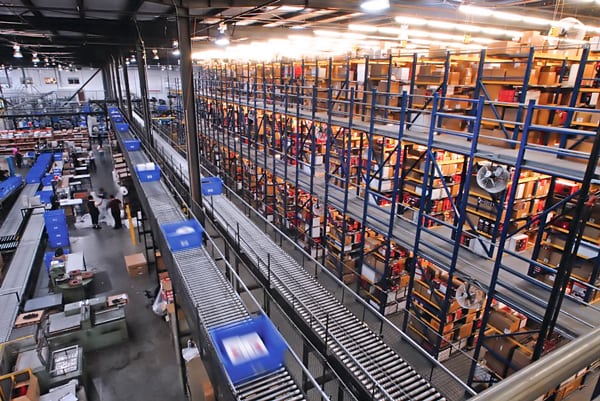It’s hard not to conclude that the U.S. will be in the midst of a recession based on economic indicators and consumer attitudes. How major the financial impact might be or how long the recession will last is less clear. Building operational resilience and developing problem/solution scenarios for your ecommerce fulfillment center prior to a recession will allow you to be nimbler.
It’s important to have a plan for addressing these challenges vs. just hoping it doesn’t occur. Hope is not a strategy. The key is to include the various department heads early in the discussions, identify areas that should be reviewed and develop a course of action.
Based on previous recessions, we have compiled a list of areas which your ecommerce fulfillment center should proactively address.
Missing Forecasts
Historically, the consumer impact means discretionary spending has pulled back, and ecommerce companies miss order and sales forecasts. What makes this potential recession so different are the existing supply chain constraints, making it difficult to get items back in stock. Missed forecasts will likely mean carrying additional inventory positions longer than anticipated. Or it may mean actively building safety stocks, taking more investment and space.
Operations that become congested with inventory will become less efficient as it tends to be double handled, driving up labor costs and taxing space use. The goal in recession proofing your operations is to be extremely efficient with labor costs and minimize the effect on operating costs.
Here are some topics that should be reviewed within your operations:
- Be sure that operations management is looped into all purchasing and marketing communications regarding sales and inventory forecasts. Historically, operations tend to be the last department to know that inventory will be a problem.
- Make sure you’ve worked with management to identify any preexisting inventory positions that are excessive or obsolete, removing them to free up critical space.
- Maximize all available space, including any additional storage and racking that should be installed.
- Taking care of labor and inventory are the two most critical issues.
To determine, the major areas for improve, our blog on conducting an ecommerce fulfillment center assessment may be helpful
Hyper-Focus on Being Customer Centric
During the last recession about 14 years ago, retailers took this approach to support the brand and sales. The operations team must be able to deliver on these same principles so as to not lose customer demand.
One aspect is supporting the customer on their preferred delivery method, whether it’s BOPIS, curbside or small parcel delivery. During the peak of COVID productivity suffered and these methods need more refinement in many companies.
Consider these aspects when developing your plan:
- What critical customer service metrics might you be missing?
- Order and item fill rates
- Order turnaround time
- Order accuracy
- Return processing turnaround time
- If you have constraints in your fulfillment center, are there opportunities to utilize a 3PL to handle some portion of fulfillment or kitting?
- Have you identified where and how you’re not currently meeting customer needs, and developed an action plan for making corrections?
Being customer centric helps maximize critical sales during a recession.
Maximize Efficiency: Do More with Less
One of the first operations line items to be slashed tends to be labor. The difficult part is that many companies don’t know their current labor metrics by department well enough to understand the potential outcome that management directs them to make.
As distribution consultants, we are constantly reinforcing with clients that you must know your numbers. You must know what it costs to fulfill an order. How many units per man hour are you picking and packing vs. your goal? What are your receiving and put-away rates? While those are major expense and productivity metrics, there are many more.
Here are some department metrics to consider.
Companies must implement productivity metrics, even if they are rudimentary initially. Labor must be scaled to meet the workload. However, if your company is looking to be customer centric and you don’t know how many FTEs it will take to fulfill the revised demand projection, you will most likely cut your labor to a dangerous level.
- If you do not have a WMS capable of providing productivity metrics, at a minimum consider how to implement throughput metrics at the shift or team level.
- Implement a plan for reviewing productivity metrics; challenge managers and supervisors to determine how to continually improve operations.
- Determine what challenges exist that keep you from being more efficient.
- Ensure your managers and supervisors reinforce management’s expectations and best practices.
Develop Problem/Solution Scenarios
One thing we have found effective with clients in dealing with the stresses of prior recessions is to think through the “what ifs?” If the “this” happens – for instance, a 10% reduction in orders from plan – “then” here’s our plan of action.
Decrease order demand: In talking with management, what are the most likely scenarios that you should take time to think through and plan for? For example, what effect will a 10% reduction in orders on your labor budget? How would you deal with a major decrease by department and number of personnel? Are there key employees you can give more responsibility to keep operating with less people?
Inventory vs. space: Is management open to identifying and liquidating obsolete and/or slow-moving merchandise to free up space? Do they foresee carrying more safety stock, requiring more space and inventory locations?
Rising freight costs: Given the rising cost of freight, what else can be done to mitigate price increases? Consider a transportation consultant to validate and potentially improve your strategy.
Summary
We’re facing escalating inflation at over 9.1%. Will this lead to a recession? Take the time now to determine scenarios, up to and including worst case, and develop plans your management may ask you to put into effect.
Brian Barry is President of F. Curtis Barry & Company

